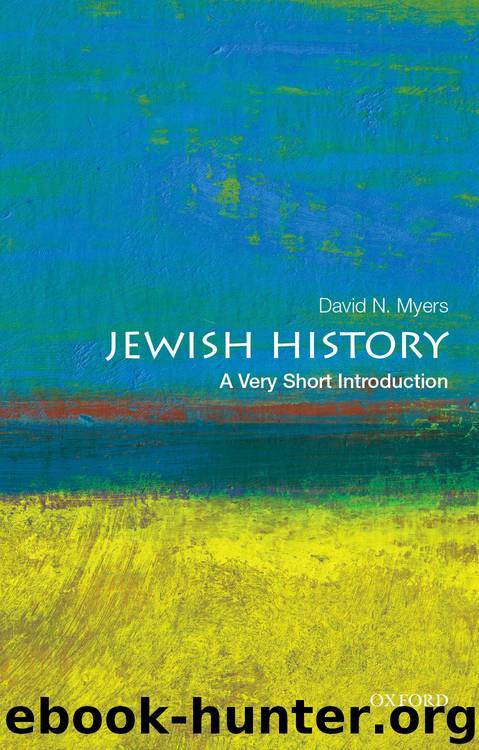Jewish History: A Very Short Introduction by David N. Myers

Author:David N. Myers
Language: eng
Format: epub
ISBN: 9780199912858
Publisher: Oxford University Press
Published: 2017-02-07T05:00:00+00:00
The secular revolution and modern Jewish cultures
By the end of the fifteenth century, a major demographic and social shift occurred in the Jewish world that had profound geographic and cultural consequences. Up to that point, the Jewish community of Spain had been the most populous, affluent, and influential in the Jewish world. During the three and a half centuries after Maimonides and his family were forced off the Iberian Peninsula in 1148, Spain was in the throes of a relentless campaign by Christians in the north of the country to capture control of southern parts from the hands of the Muslims. In the midst of this drive to create an all-Christian peninsula, Jews too came under pressure. They were subject to violent waves of forced conversions in the late fourteenth and early fifteenth centuries that generated thousands of conversos, some of whom maintained Jewish rituals secretly in their homes. In fact, it was in response to the “Judaizing” activity of conversos that the Spanish monarchs, Ferdinand and Isabella, introduced the Inquisition in Spain in 1478. Fourteen years later, they decided to complete the ethnic cleansing of Spain by expelling the Jews in 1492. Among other effects, the Edict of Expulsion marked the birth of the great Sephardic Jewish diaspora, in both its eastern (Ottoman) and its western (European) sectors.
Two towering figures of Sephardic origin, products of east and west respectively, emerged in the seventeenth century to alter the complexion of medieval Jewish culture. One was Shabtai Zevi, the Turkish-born false messiah who attracted hundreds of thousands of adherents to his movement, before he converted to Islam. The second figure came from the western Sephardi diaspora of Holland. Benedict, or Baruch, Spinoza was the descendent of Portuguese conversos who had moved to Amsterdam in the early seventeenth century. Like Shabtai Zevi, Spinoza grew up in a traditionally observant setting. His intellectual curiosity as a young man led him to a circle of non-Jewish free thinkers who encouraged his own unconventional thinking about Judaism, religion in general, and the relationship between church and state. Spinoza’s iconoclasm led to confrontations with Jewish communal officials, culminating in his excommunication in 1656 from the Amsterdam community owing to his “horrible heresies.” Spinoza never formally returned to Judaism, but neither did he convert to Christianity. Indeed, it was said of him that he was the first person to leave the confines of the Jewish community without converting.
This statement suggests that there was in Spinoza’s time, and perhaps as a result of his actions, a secular revolution that carved out a space in society that was beyond the reach of religious authorities, where one could think freely and without inhibition about sensitive matters. Spinoza dwelt alone in this new “secular” space after his excommunication, during which time he wrote a number of seminal works of philosophy. In one of them, the Theological-Political Treatise (1670), he gave articulate voice to a host of doubts that may have prompted his exclusion from the Jewish community fourteen years earlier—about the
Download
This site does not store any files on its server. We only index and link to content provided by other sites. Please contact the content providers to delete copyright contents if any and email us, we'll remove relevant links or contents immediately.
| Africa | Americas |
| Arctic & Antarctica | Asia |
| Australia & Oceania | Europe |
| Middle East | Russia |
| United States | World |
| Ancient Civilizations | Military |
| Historical Study & Educational Resources |
Cecilia; Or, Memoirs of an Heiress — Volume 1 by Fanny Burney(32408)
Cecilia; Or, Memoirs of an Heiress — Volume 3 by Fanny Burney(31811)
Cecilia; Or, Memoirs of an Heiress — Volume 2 by Fanny Burney(31783)
The Secret History by Donna Tartt(18802)
Sapiens: A Brief History of Humankind by Yuval Noah Harari(14203)
Leonardo da Vinci by Walter Isaacson(13139)
The Radium Girls by Kate Moore(11896)
Sapiens by Yuval Noah Harari(5278)
How Democracies Die by Steven Levitsky & Daniel Ziblatt(5107)
The Wind in My Hair by Masih Alinejad(5020)
Homo Deus: A Brief History of Tomorrow by Yuval Noah Harari(4795)
Endurance: Shackleton's Incredible Voyage by Alfred Lansing(4653)
The Silk Roads by Peter Frankopan(4429)
Man's Search for Meaning by Viktor Frankl(4381)
Millionaire: The Philanderer, Gambler, and Duelist Who Invented Modern Finance by Janet Gleeson(4347)
The Rape of Nanking by Iris Chang(4123)
Joan of Arc by Mary Gordon(4000)
The Motorcycle Diaries by Ernesto Che Guevara(3984)
Hitler in Los Angeles by Steven J. Ross(3889)
